On the Use of a New Class of Simplified Multi-Window Iris Notch in the Design of Ultra-Compact High-Rejection Waveguide Filters for Satellite Links
Abstract
1. Introduction
2. Filter Design Procedure
2.1. Iris Analysis
2.2. Receiver (Rx) Filter Design
2.3. Transmitter (Tx) Filter Design
3. Discussion on Filter Compactness
4. Filter Manufacturing and Assembly
5. Filter Characterization and Results
6. Conclusions
Author Contributions
Funding
Conflicts of Interest
References
- Miyazaki, M.; Yukawa, H.; Nishino, T.; Urasaki, S.; Katagi, T. Design of iris-coupled broadband waveguide filter using modified reflection-zero frequencies. Electron. Commun. Jpn. 2000, 83, 59–67. [Google Scholar] [CrossRef]
- Kocbach, J.; Folgerø, K. Design procedure for waveguide filters with cross-couplings. In Proceedings of the 2002 IEEE MTT-S International Microwave Symposium Digest, Seattle, WA, USA, 2–7 June 2002; pp. 1449–1452. [Google Scholar]
- Morro, J.V.; Pacheco, P.S.; Gonzalez, H.E.; Esbert, V.B.; Martín, C.B.; Calduch, M.T.; Borrás, S.C.; Martínez, B.G. Fast automated design of waveguide filters using agressive space mapping with a new segmentation strategy and a hybrid optimization algorithm. IEEE Microw. Theory Tech. 2005, 53, 1130–1142. [Google Scholar]
- Leal-Sevillano, C.A.; Pisano, G.; Montejo-Garai, J.R.; Maffei, B.; Ruiz-Cruz, J.A.; Ng, M.W.; Rebollar, J.M. Development of low loss waveguide filters for radio-astronomy applications. Infrared Phys. Tech. 2013, 61, 224–229. [Google Scholar] [CrossRef]
- Amari, S.; Rosenberg, U. Synthesis and design of novel in-line filters with one or two real transmission zeros. IEEE Trans. Microw. Theory Tech. 2004, 52, 1464–1478. [Google Scholar] [CrossRef]
- Zhang, Q.; Lu, Y. Design of wide-band pseudo-elliptic waveguide filters with cavity-backed inverters. IEEE Microw. Wirel. Comp. Lett. 2010, 20, 604–606. [Google Scholar] [CrossRef]
- Carceller, C.; Soto, P.; Boria, V.; Guglielmi, M. Capacitive obstacle realizing multiple transmission zeros for in-line rectangular waveguide filters. IEEE Microw. Wirel. Comp. Lett. 2016, 26, 795–797. [Google Scholar] [CrossRef]
- El Sabbagh, M.; Zaki, K.A.; Yao, H.-W.; Yu, M. Full-wave analysis of coupling between combline resonators and its application to combline filters with canonical configurations. IEEE Trans. Microw. Theory Tech. 2001, 49, 2384–2393. [Google Scholar] [CrossRef]
- Levy, R.; Snyder, R.V.; Matthaei, G. Design of microwave filters. IEEE Trans. Microw. Theory Tech. 2002, 50, 783–793. [Google Scholar] [CrossRef]
- Subramanyam, A.V.G.; Siva Reddy, D.; Hariharan, V.K.; Srinivasan, V.V.; Chakrabarty, A. High power combline filter for deep space applications. Int. J. Microw. Sci. Tech. 2014, 2014, 396494. [Google Scholar] [CrossRef]
- Levy, R. Tapered corrugated waveguide low-pass filters. IEEE Trans. Microw. Theory Tech. 1973, 21, 526–532. [Google Scholar] [CrossRef]
- Xu, Z.B.; Guo, J.; Quian, C.; Dou, W.B. A novel miniature transmit reject filter for Ku-band VSAT transceivers. In Proceedings of the 2008 IEEE MTT-S International Microwave Workshop Series on Art of Miniaturizing RF and Microwave Passive Components, Chengdu, China, 14–15 December 2008; pp. 113–115. [Google Scholar]
- Teberino, F.; Arregui, I.; Soto, P.; Laso, M.A.G.; Boria, V.E.; Guglielmi, M. High-performance compact diplexers for Ku/K-band satellite applications. IEEE Trans. Microw. Theory Tech. 2017, 65, 3866–3876. [Google Scholar] [CrossRef]
- Bastioli, S.; Marcaccioli, L.; Sorrentino, R. Waveguide pseudoelliptic filters using slant and transverse rectangular ridge resonators. IEEE Trans. Microw. Theory Tech. 2008, 56, 3129–3136. [Google Scholar] [CrossRef]
- Rosenberg, U.; Amari, S. A novel band-reject element for pseudoelliptic bandstop filters. IEEE Trans. Microw. Theory Tech. 2007, 55, 742–746. [Google Scholar] [CrossRef]
- Barrio-Garrido, R.M.; Llorente-Romano, S.; Salazar-Palma, M. Design of Ka band highly selective wideband band-pass filters using directly coupled resonant irises. In Proceedings of the IEEE Antennas and Propagation Society International Symposium. Digest. Held in conjunction with: USNC/CNC/URSI North American Radio Sci. Meeting, Columbus, OH, USA, 22–27 June 2003; pp. 1161–1164. [Google Scholar]
- Barrio-Garrido, R.M.; Llorente-Romano, S.; Salazar-Palma, M.; Oñoro-Navarro, A.; Hidalgo-Carpintero, I. Design, construction and experimental characterization of a broadband highly selective filter in waveguide technology in Ka band. In Proceedings of the 2006 IEEE MTT-S International Microwave Symposium Digest, San Francisco, CA, USA, 11–16 June 2006; pp. 250–253. [Google Scholar]
- Yang, R.; Omar, A.S. Investigation of multiple rectangular aperture irises in rectangular waveguide using TExmn-modes. IEEE Trans. Microw. Theory Tech. 1993, 41, 1369–1374. [Google Scholar] [CrossRef]
- Kirilenko, A.A.; Mos’pan, L.P. Reflection resonances of two-aperture irises in rectangular waveguide. In Proceedings of the 29th European Microwave Conference, Munich, Germany, 5–7 October 1999; pp. 28–31. [Google Scholar]
- Leal-Sevillano, C.A.; Montejo-Garai, J.R.; Ruiz-Cruz, J.A.; Rebollar, J.M. Wideband equivalent circuit for multi-aperture multi-resonant waveguide irises. IEEE Trans. Microw. Theory Tech. 2016, 64, 724–732. [Google Scholar] [CrossRef]
- Rodriguez-Berral, R.; Mesa, F.; Medina, F. Resonant modes of a waveguide iris discontinuity: Interpretation in terms of canonical circuits. IEEE Trans. Microw. Theory Tech. 2018, 66, 2059–2069. [Google Scholar] [CrossRef]
- Tsuji, M.; Deguchi, H. A new frequency selective window for constructing waveguide bandpass filters with multiple attenuation poles. Prog. Electromagn. Res. 2011, 20, 139–153. [Google Scholar] [CrossRef]
- Zhang, Y.; Meng, H.; Wu, K. Synthesis of microwave filters with dispersive coupling using isospectral flow method. In Proceedings of the 2019 IEEE MTT-S International Microwave Symposium (IMS), Boston, MA, USA, 2–7 June 2019; pp. 846–848. [Google Scholar]
- Zhang, Y.; Meng, H.; Wu, K. Direct synthesis and design of dispersive waveguide bandpass filters. IEEE Trans. Microw. Theory Tech. 2020, 68, 1678–1687. [Google Scholar] [CrossRef]
- Marcuvitz, N. Waveguide Handbook; McGraw-Hill: New York, NY, USA, 1951; pp. 217–335. [Google Scholar]
- Rizzi, P.A. Microwave Engineering: Passive Circuits; Prentice-hall Int.: Upper Saddle River, NJ, USA, 1988; pp. 299–346. [Google Scholar]
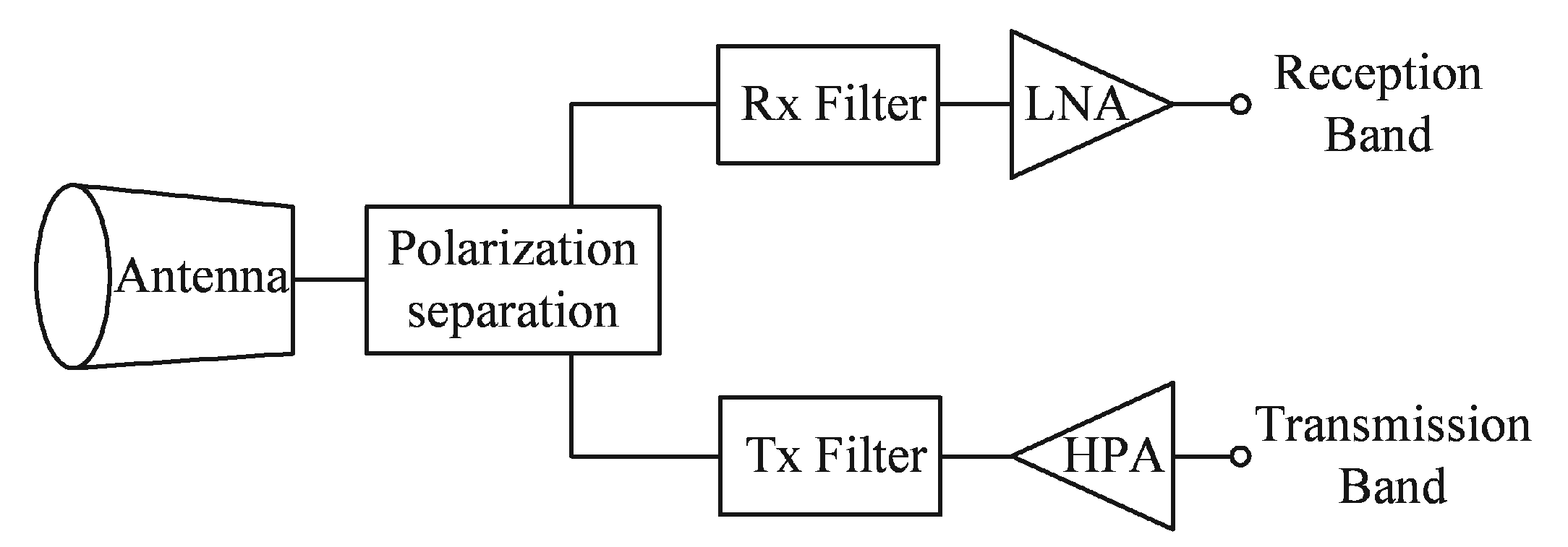

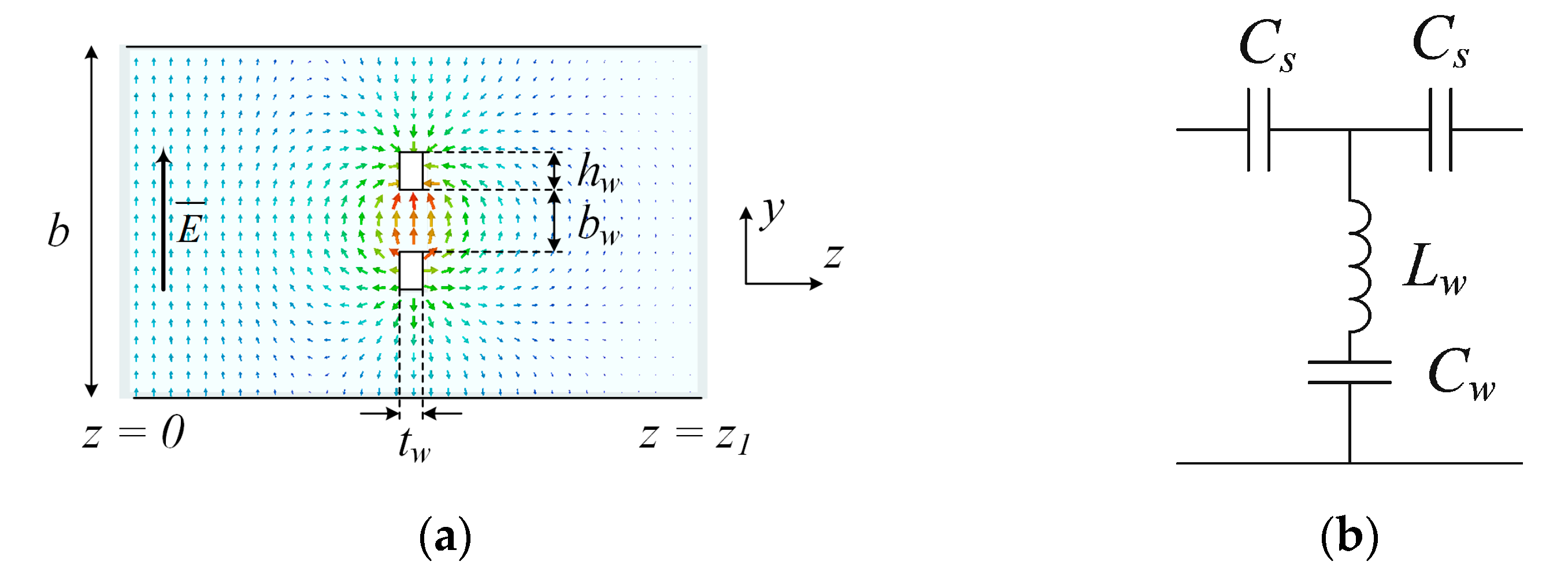
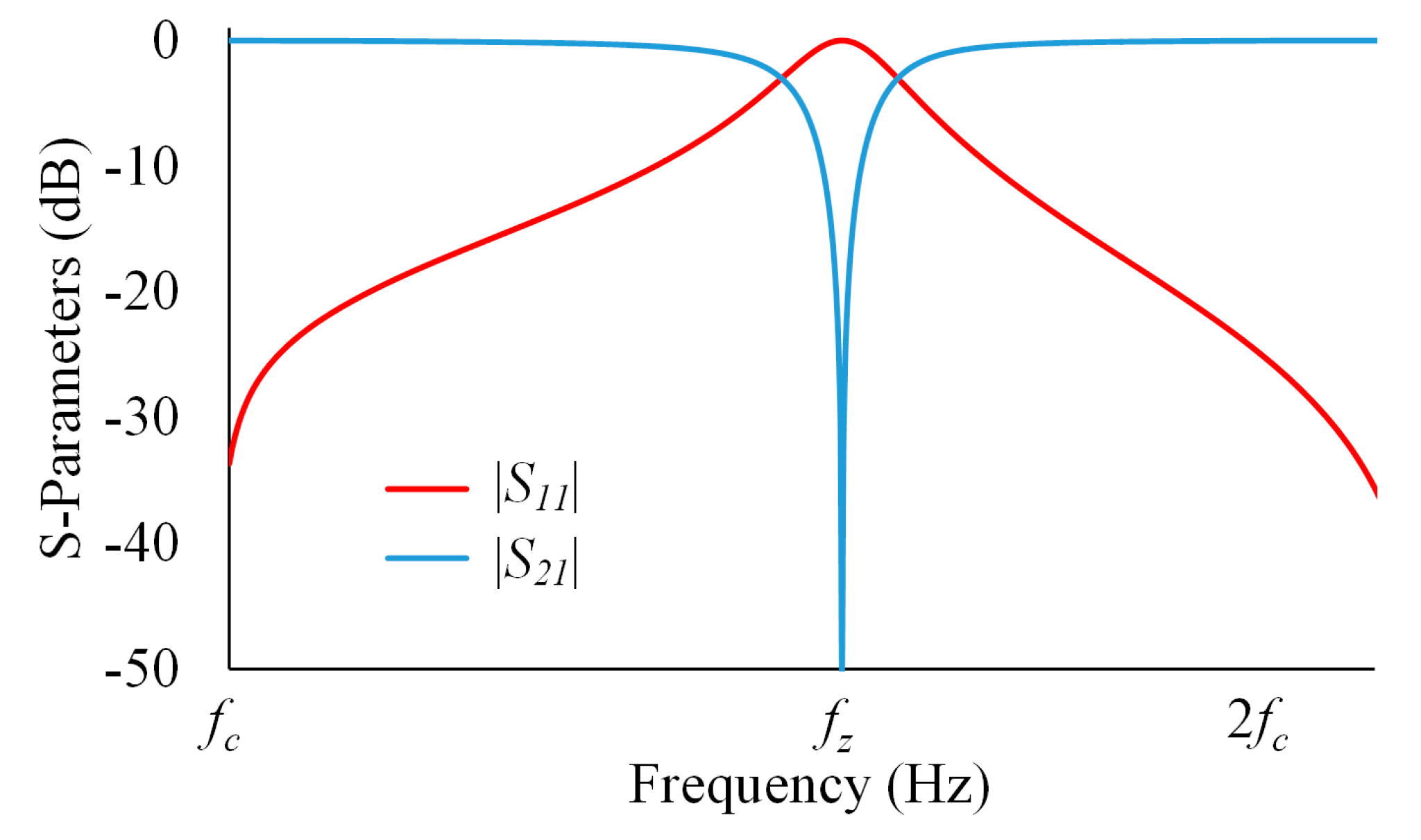
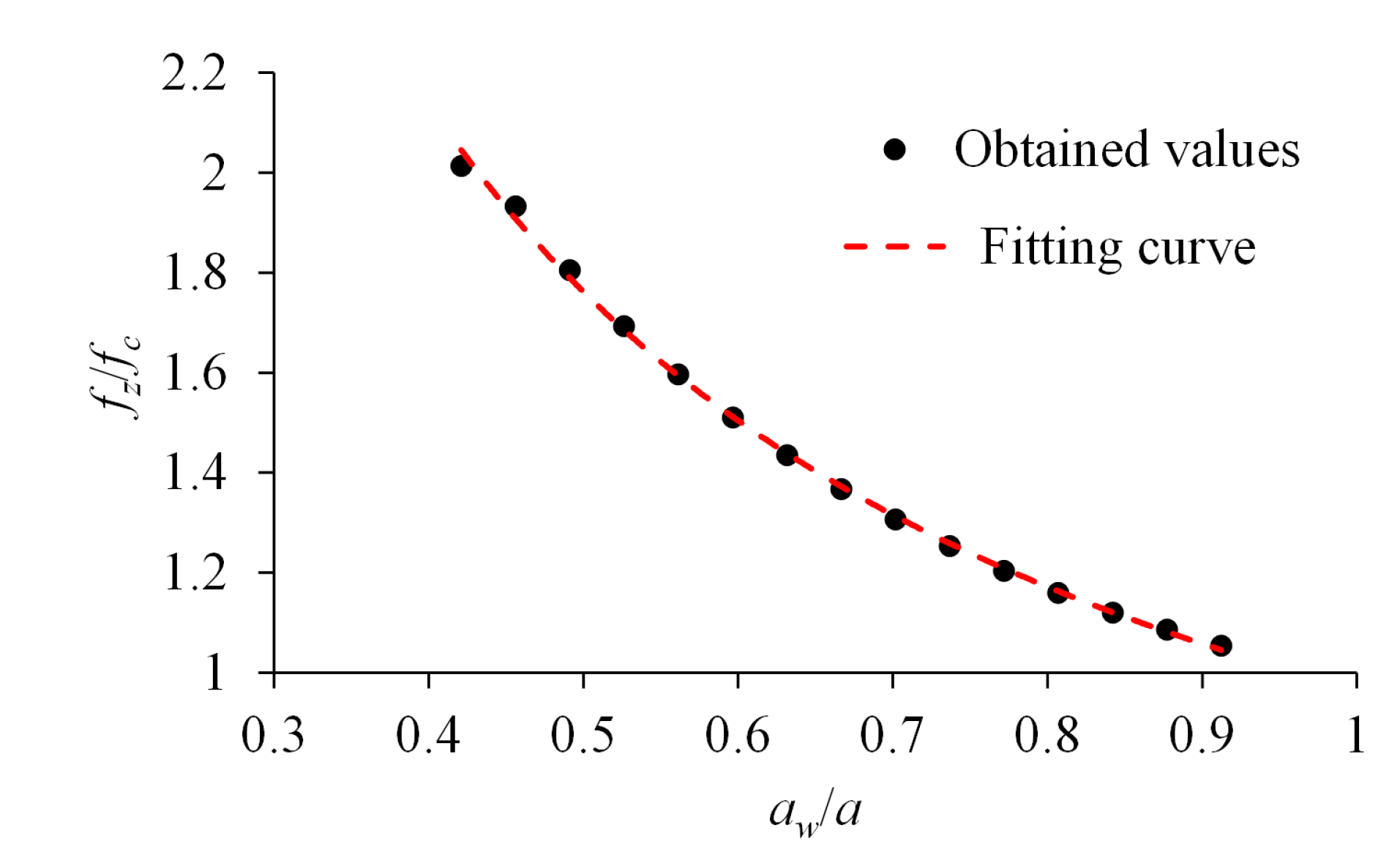
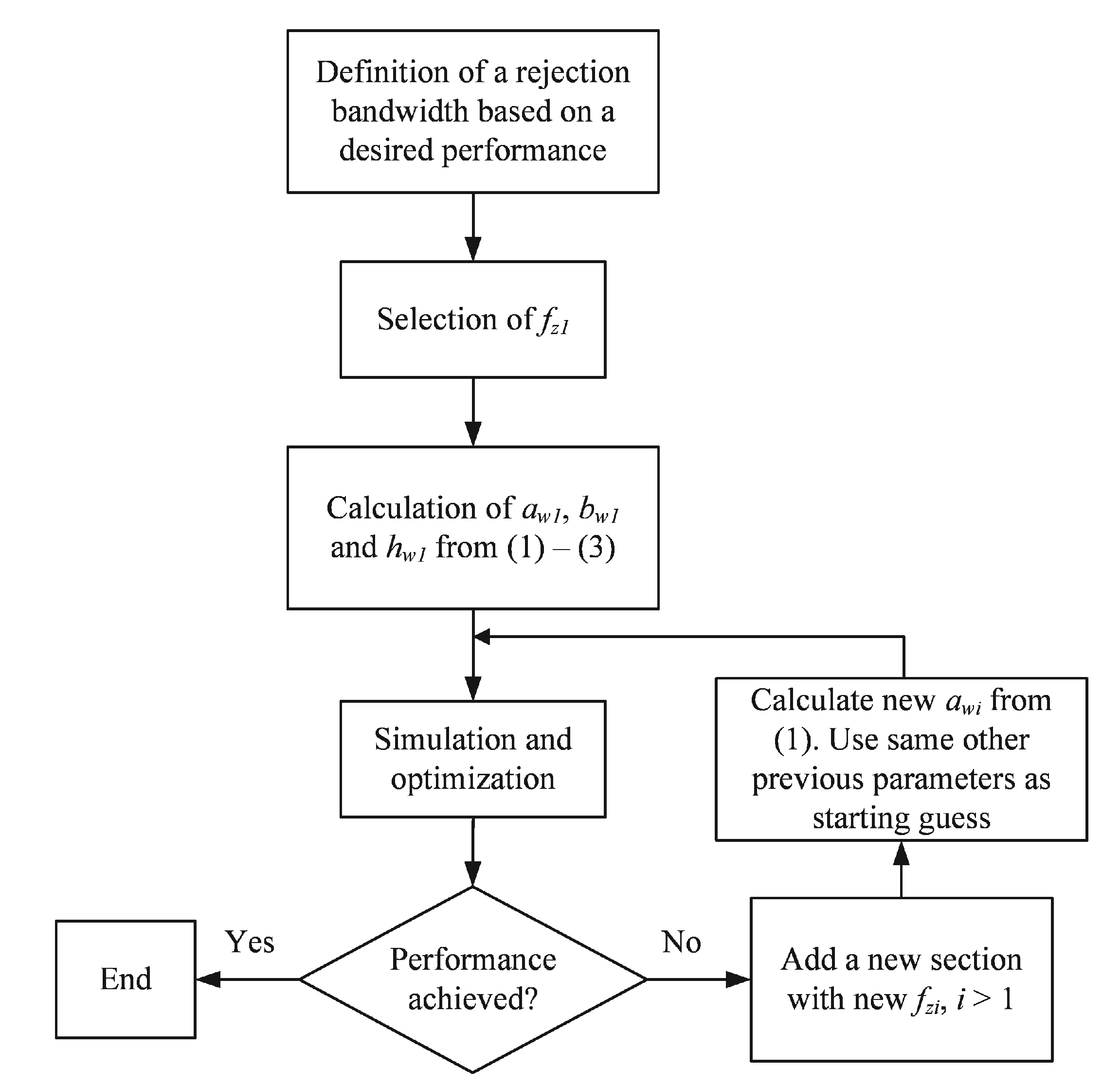
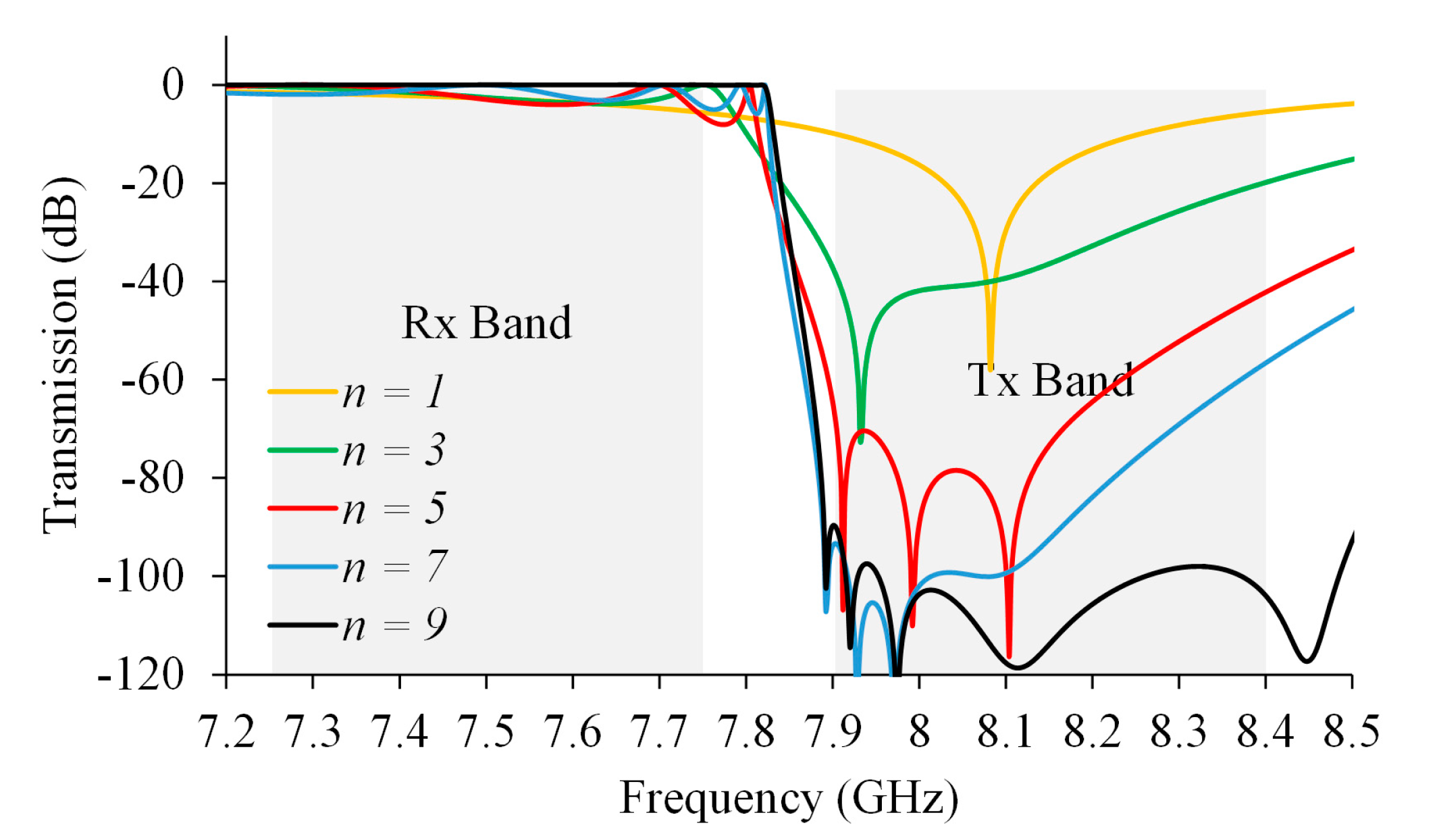


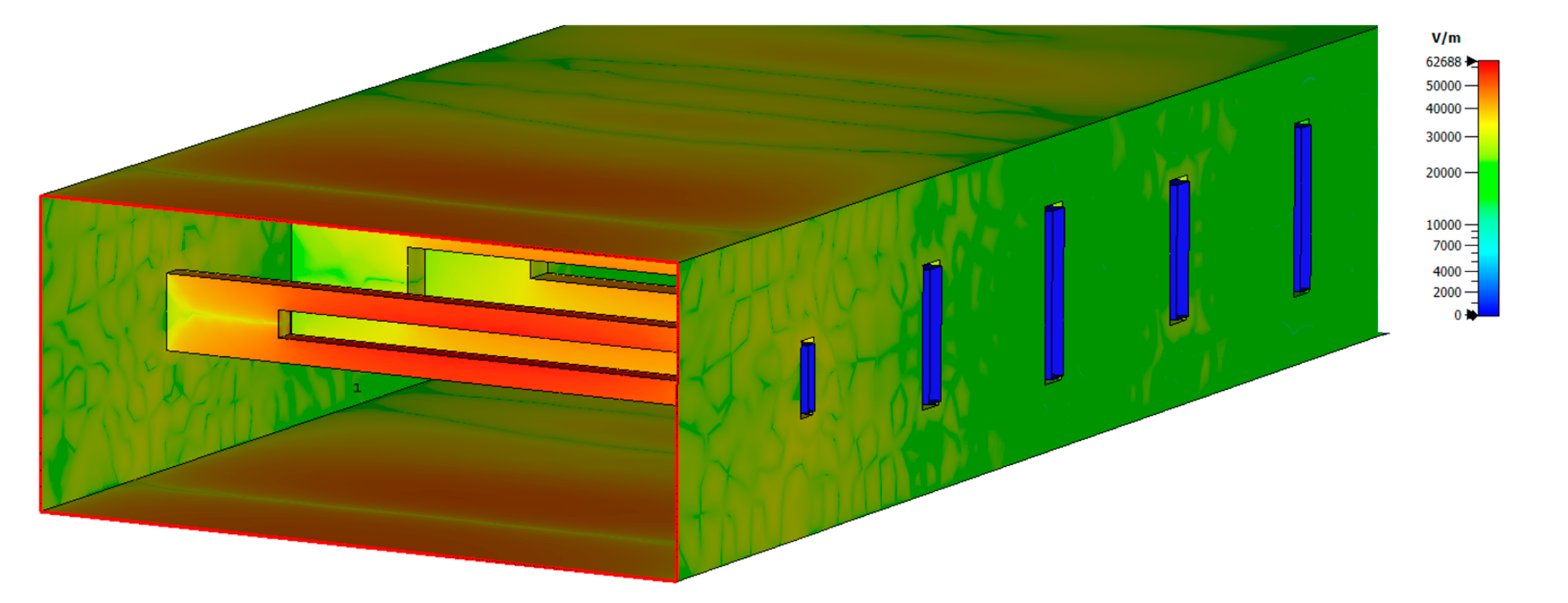
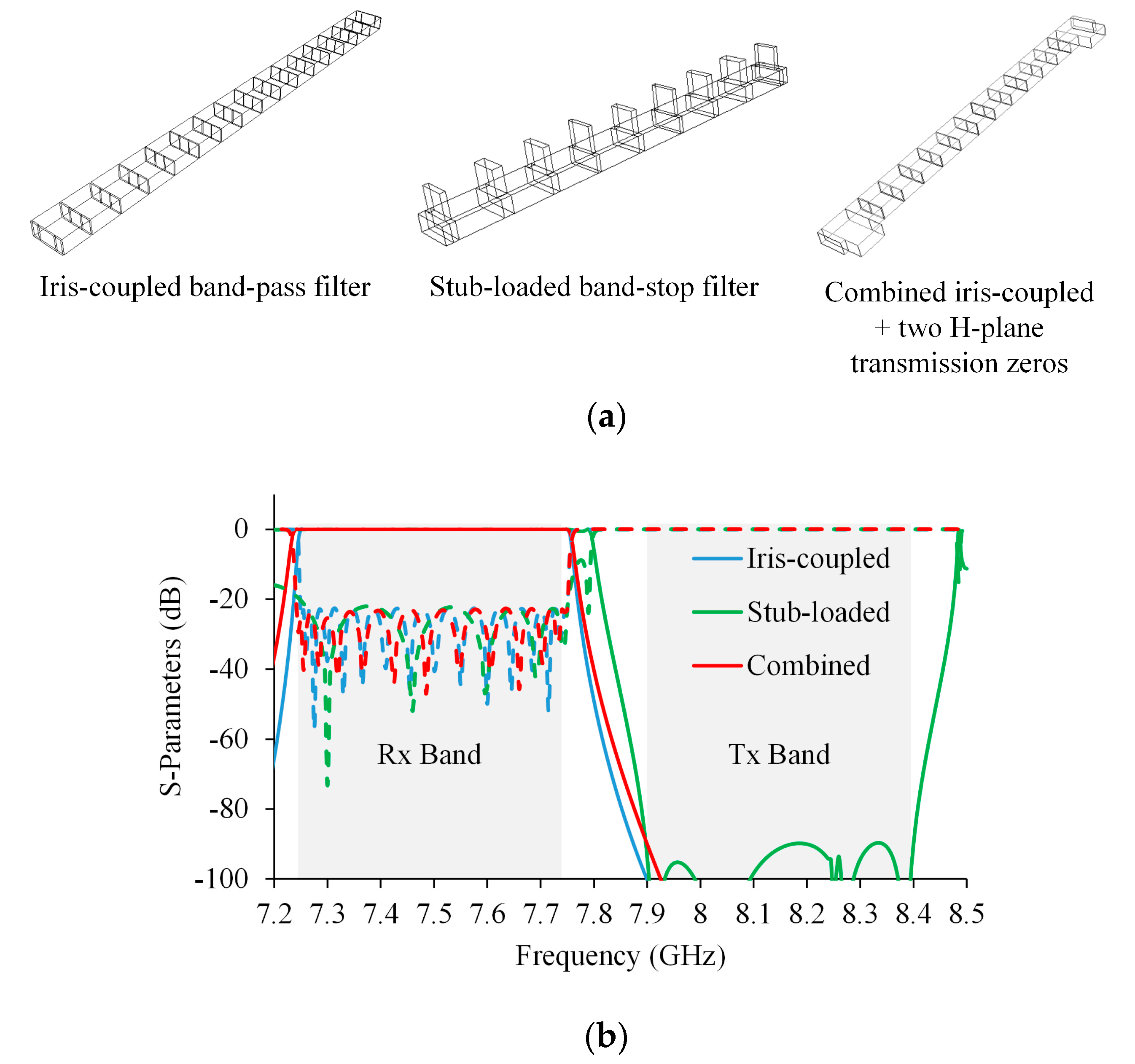

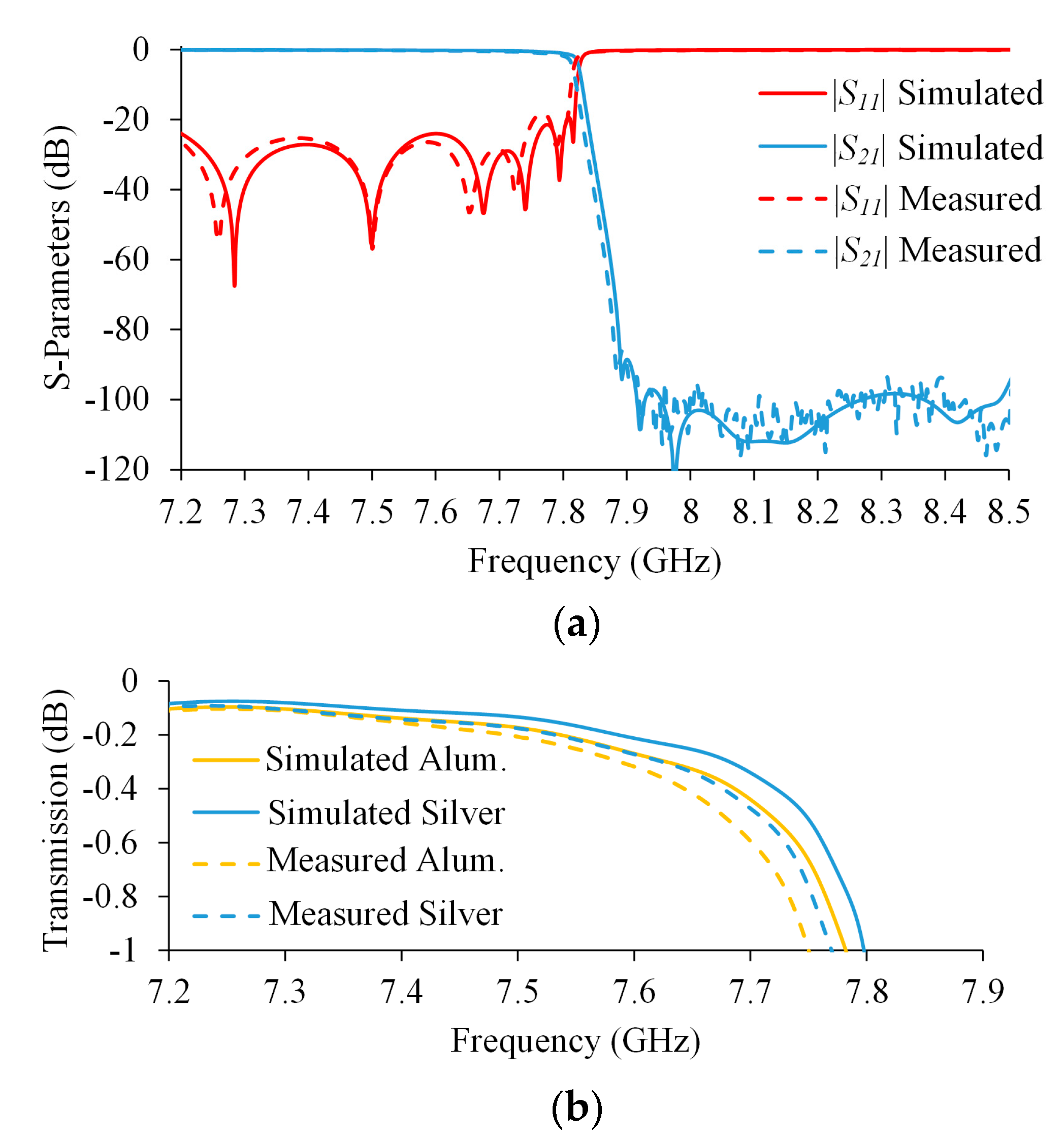
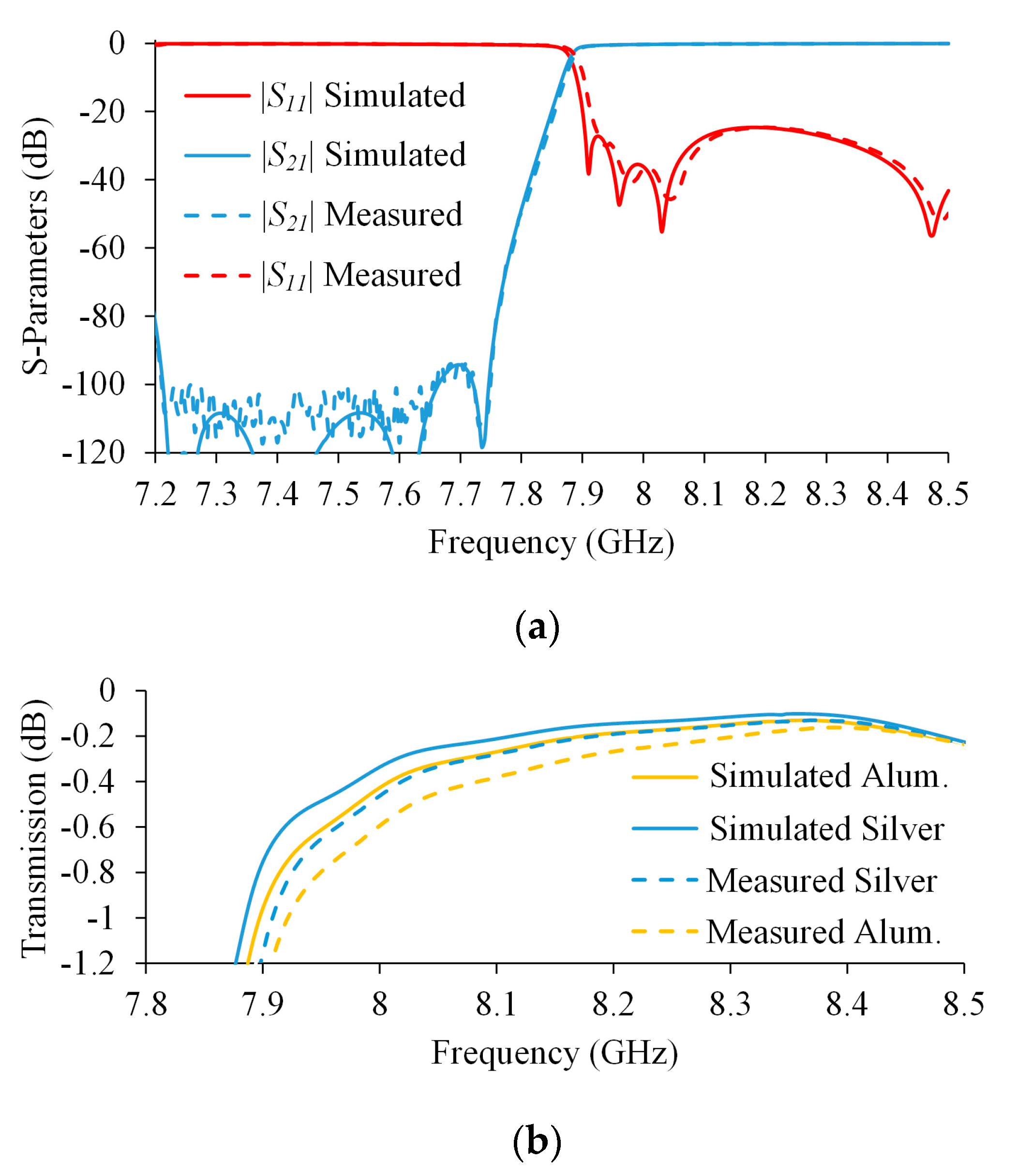
| i | aw (mm) | bw (mm) | tw (mm) | hw (mm) | dsep (mm) | fz (GHz) |
|---|---|---|---|---|---|---|
| 1 | 16.10 | 2.14 | 2.43 | 1.44 | 6.10 | 8.50 |
| 2 | 16.02 | 2.62 | 1.06 | 2.14 | 4.36 | 8.05 |
| 3 | 16.00 | 3.04 | 2.31 | 2.31 | 5.20 | 8.16 |
| 4 | 16.04 | 3.02 | 1.19 | 1.19 | 5.69 | 8.03 |
| 5 | 16.00 | 3.02 | 1.45 | 1.45 | - | 8.08 |
| i | aw (mm) | bw (mm) | tw (mm) | hw (mm) | dsep (mm) | fz (GHz) |
|---|---|---|---|---|---|---|
| 1 | 18.36 | 1.13 | 0.97 | 0.98 | 9.04 | 7.74 |
| 2 | 17.92 | 2.88 | 1.36 | 1.46 | 8.74 | 7.42 |
| 3 | 18.05 | 3.00 | 1.38 | 2.08 | 9.03 | 7.21 |
| 4 | 17.50 | 2.39 | 1.41 | 1.73 | 9.05 | 7.64 |
| 5 | 18.06 | 3.05 | 1.24 | 2.00 | 8.90 | 7.19 |
| 6 | 17.38 | 3.00 | 1.49 | 2.00 | - | 7.47 |
| Ref. | Frequency Range (GHz) | Rejection Slope (dB/GHz) | Number Sections | Return Loss (dB) | Insertion Loss (dB) | Length (λg) |
|---|---|---|---|---|---|---|
| [17] | 27.2–30.7 | 37 | 9 | 21 | - | ~3.25 |
| [16] | ~27–30.5 | 22 | 7 | 25 | - | ~2 |
| [4] | 85–105 | 15 | 10 | 15 | 0.4 | 4 |
| [12] | 11–13.5 | 70 | 5 | 12 | 0.3 | 1.3 |
| [6] | 9.51–10.64 | 25 | 4 | 20 | - | ~2.4 |
| [14] | 10.1–10.4 | 220 | 3 | 20 | 0.35 | 1.42 |
| This work (Rx) | 7.25–7.75 | 600 | 9 | 25 | 0.24 | 1.5 |
| This work (Tx) | 7.9–8.4 | 600 | 11 | 25 | 0.38 | 2 |
© 2020 by the authors. Licensee MDPI, Basel, Switzerland. This article is an open access article distributed under the terms and conditions of the Creative Commons Attribution (CC BY) license (http://creativecommons.org/licenses/by/4.0/).
Share and Cite
Cano, J.L.; Mediavilla, A.; Tazon, A. On the Use of a New Class of Simplified Multi-Window Iris Notch in the Design of Ultra-Compact High-Rejection Waveguide Filters for Satellite Links. Electronics 2020, 9, 1221. https://doi.org/10.3390/electronics9081221
Cano JL, Mediavilla A, Tazon A. On the Use of a New Class of Simplified Multi-Window Iris Notch in the Design of Ultra-Compact High-Rejection Waveguide Filters for Satellite Links. Electronics. 2020; 9(8):1221. https://doi.org/10.3390/electronics9081221
Chicago/Turabian StyleCano, Juan Luis, Angel Mediavilla, and Antonio Tazon. 2020. "On the Use of a New Class of Simplified Multi-Window Iris Notch in the Design of Ultra-Compact High-Rejection Waveguide Filters for Satellite Links" Electronics 9, no. 8: 1221. https://doi.org/10.3390/electronics9081221
APA StyleCano, J. L., Mediavilla, A., & Tazon, A. (2020). On the Use of a New Class of Simplified Multi-Window Iris Notch in the Design of Ultra-Compact High-Rejection Waveguide Filters for Satellite Links. Electronics, 9(8), 1221. https://doi.org/10.3390/electronics9081221







